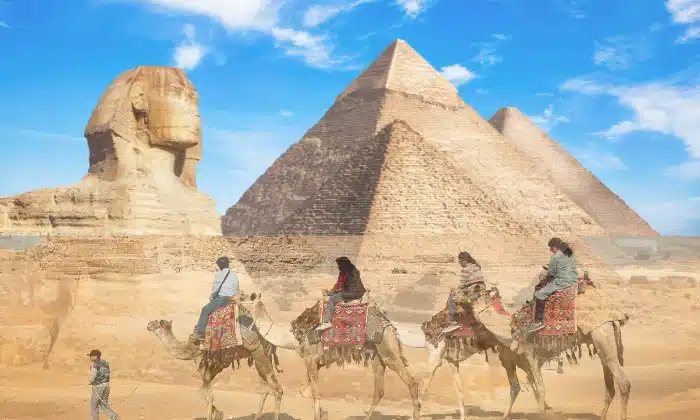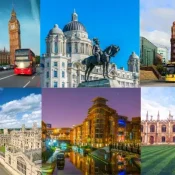
Discover Egypt
Discover Egypt. Best time to travel to Egypt.
Embark on a mesmerizing journey through ancient Egypt
Egypt, officially known as the Arab Republic of Egypt, is a country located primarily in North Africa, with the Sinai Peninsula forming a land bridge to Southwest Asia. Embark on a mesmerizing journey through ancient Egypt and experience the rich history and culture of this fascinating civilization as you explore iconic landmarks such as the Great Pyramids of Giza, the Sphinx, and the Valley of the Kings.
Explore the powerful pharaohs, the mystical rituals of the ancient Egyptians, and the advancements in science, mathematics, and architecture that made this civilization so remarkable. Dive into the mysteries of the hieroglyphic language, deciphering its hidden meanings and uncovering the secrets of the ancient tombs.
Egypt is bordered by the Mediterranean Sea to the north, the Gaza Strip and Israel to the northeast, the Red Sea to the east, Sudan to the south, and Libya to the west. The Nile River, the longest river in the world, flows through Egypt, providing fertile land along its banks. Alexandria is a Mediterranean port city in Egypt. Founded by Alexander the Great in 332 BCE, Alexandria was an Egyptian capital for over 1000 years and is to this day an important economic centre.
Cairo is the capital of Egypt which is also the largest city in the country. Cairo is a major cultural, historical, and economic hub in the Middle East and Africa. Egypt has one of the longest and richest histories of any country in the world, with a recorded history dating back over 5,000 years. Ancient Egypt was one of the world’s earliest civilizations, known for its monumental architecture, such as the pyramids and temples, and advancements in science, mathematics, and writing.
Egypt is the 29th largest country in the world and is the largest Arab country with a population of 111 million people and Gross domestic product of 476.7 billion. Egyptian people are very friendly.
The Sphinx
The Sphinx is a famous monumental sculpture located on the Giza Plateau near Cairo, Egypt.
The Sphinx is a limestone statue depicting a mythical creature with the body of a lion and the head of a human, often believed to represent the pharaoh Khafre (also known as Chephren). It measures approximately 73 meters (240 feet) long from paw to tail and stands about 20 meters (66 feet) tall. It is situated on the western bank of the Nile River, facing eastward towards the rising sun. It is part of the larger Giza Necropolis, which also includes the Great Pyramid of Giza and other ancient structures. The construction of the Sphinx is believed to have been built during the reign of Pharaoh Khafre, around 2500 BCE, during the Old Kingdom period of ancient Egypt.
The Pyramid
The Pyramids of Egypt are among the most iconic and enduring symbols of ancient civilization. The majority of Egypt’s pyramids are located on the Giza Plateau, near Cairo, Egypt’s capital city. The Giza complex includes the Great Pyramid of Giza (also known as the Pyramid of Khufu or Cheops), the Pyramid of Khafre (or Chephren), the Pyramid of Menkaure (or Mykerinos), and the Great Sphinx.
The pyramids were built as tombs for pharaohs and royalty during the Old Kingdom period of ancient Egypt, between approximately 2600 BCE and 2500 BCE. They were constructed using large limestone blocks, quarried and transported from nearby sites. The construction process involved thousands of laborers and skilled craftsmen working over many years.
The Great Pyramid of Giza is the largest and most famous of Egypt’s pyramids. It was built for Pharaoh Khufu (Cheops) and originally stood at a height of 146.6 meters (481 feet), making it the tallest man-made structure in the world for over 3,800 years. The pyramid is estimated to have been built over a period of 20 to 30 years.
Temple of Karnak
The Temple of Karnak, located near Luxor in Egypt, is one of the largest and most impressive temple complexes in the world. It is dedicated to the principal god of the Theban Triad, Amun-Ra, along with his wife Mut and their son Khonsu. Construction of the temple complex began during the Middle Kingdom period (circa 2000 BCE) and continued over the course of several centuries, with contributions from many pharaohs, including Senusret I, Amenhotep III, and Ramesses II.
The Temple of Karnak is a vast complex consisting of multiple temples, chapels, pylons, and halls covering an area of over 200 acres. The most prominent feature of the complex is the Great Hypostyle Hall, a massive hall with 134 columns, each standing over 23 meters (75 feet) tall. The complex also includes the Precinct of Amun-Re, the Precinct of Mut, the Precinct of Montu, and the Temple of Khonsu.
Karnak was the main religious center of ancient Egypt during the New Kingdom period (circa 1550–1070 BCE). It was believed to be the dwelling place of the gods and the site of their annual festival, the Opet Festival, during which the statues of Amun, Mut, and Khonsu were paraded through the temple complex.
Ras Mohammed National Park
Ras Mohammed National Park is a protected area located at the southern tip of the Sinai Peninsula in Egypt, where the Gulf of Suez meets the Gulf of Aqaba. It was established in 1983 to protect the unique marine and terrestrial ecosystems found in the region. It was declared a protected area due to its exceptional biodiversity and ecological significance.
The park covers an area of approximately 480 square kilometers (185 square miles) and encompasses a variety of habitats, including coral reefs, mangrove forests, salt marshes, and desert landscapes. The park’s coastal area is characterized by dramatic cliffs and sandy beaches, while its marine environment is renowned for its vibrant coral reefs and diverse marine life.
Ras Mohammed National Park is home to a diverse array of marine species, including over 1,000 species of fish, hundreds of species of coral, and a variety of marine mammals, sea turtles, and invertebrates. The park’s coral reefs are considered some of the healthiest and most biodiverse in the Red Sea, making it a popular destination for snorkeling and scuba diving enthusiasts.
In addition to its marine life, Ras Mohammed National Park supports a variety of terrestrial wildlife, including desert foxes, ibex, gazelles, and numerous bird species. The park’s mangrove forests provide important habitat for migratory birds and serve as a breeding ground for fish and other marine organisms.
The Museum of Egyptian Antiquities
The Museum of Egyptian Antiquities, commonly known as the Egyptian Museum or the Museum of Cairo, is one of the most renowned and important museums in the world, located in Cairo, Egypt.
The Egyptian Museum was founded in 1835 by the famous French archaeologist Auguste Mariette under the patronage of Muhammad Ali Pasha, the ruler of Egypt at the time. Originally housed in a building near the Ezbekeyah Garden, the museum was later moved to its current location in Tahrir Square in 1902.
The museum is home to an extensive collection of artifacts spanning over 5,000 years of Egyptian history, from the prehistoric era to the Greco-Roman period. Its collection includes over 120,000 items, including statues, reliefs, sarcophagi, jewelry, and papyri, many of which are of immense historical and artistic significance.
Some of the most famous artifacts housed in the Egyptian Museum include the treasures of Tutankhamun, including his iconic golden mask, sarcophagus, and funerary objects. Other notable exhibits include the Narmer Palette, the Rosetta Stone, the statue of Khufu (Cheops), and the mummy of Ramses II.
The museum’s neoclassical building was designed by French architect Marcel Dourgnon and features a grand facade adorned with columns and sculptures.
Valley of the Kings
The Valley of the Kings is a renowned archaeological site located on the west bank of the Nile River near the city of Luxor in Egypt. It served as the burial site for many of the pharaohs and other elite members of ancient Egypt’s New Kingdom (approximately 1539–1075 BCE). It was chosen as a burial site due to its secluded location and natural rock formations, which provided an ideal setting for the construction of elaborate tombs.
The Valley of the Kings is home to over 60 rock-cut tombs, many of which are elaborately decorated with hieroglyphs, paintings, and reliefs depicting scenes from the afterlife and the journey of the deceased. The tombs vary in size and complexity, ranging from simple pits to multi-chambered structures with intricate decorations.
Some of the most famous tombs in the Valley of the Kings include the tomb of Tutankhamun (KV62), discovered nearly intact by Howard Carter in 1922, and the tomb of Ramesses VI (KV9), known for its well-preserved decorations and long descending corridor.
The Valley of the Kings was known to the ancient Egyptians as “The Great and Majestic Necropolis of the Millions of Years of the Pharaoh, Life, Strength, Health in The West of Thebes.” Despite its prominence, the valley was looted in antiquity, and many of its tombs were subsequently forgotten. The modern exploration and excavation of the valley began in the 19th century, leading to the discovery of numerous tombs and artifacts.
Abu Simbel Temple Complex
The Abu Simbel Temple Complex is a UNESCO World Heritage Site located in southern Egypt, near the border with Sudan. This Complex was built during the reign of Pharaoh Ramesses II in the 13th century BCE (around 1264–1244 BCE). The complex consists of two temples: the Great Temple of Ramesses II and the smaller Temple of Hathor and Nefertari.
The temples were built to commemorate Ramesses II’s victory at the Battle of Kadesh and to honor the gods Amun, Ra-Horakhty, Ptah, and the deified Ramesses II himself. The temples served as centers of worship and pilgrimage during ancient times.
The Great Temple of Ramesses II is the larger and more famous of the two temples. It features four colossal statues of Ramesses II seated on thrones, each standing at approximately 20 meters (66 feet) tall. The facade of the temple is adorned with intricate carvings depicting scenes from Ramesses II’s military victories and religious rituals.
Luxor Temple
Luxor Temple is an ancient Egyptian temple complex located on the east bank of the Nile River in Luxor, Egypt. It was constructed during the New Kingdom period of ancient Egypt, approximately between 1400 BCE and 1200 BCE. It was built primarily during the reigns of Amenhotep III (1390–1352 BCE) and Ramesses II (1279–1213 BCE), although later pharaohs also contributed to its construction and expansion.
Luxor Temple was dedicated to the Theban Triad of gods: the god Amun, his wife Mut, and their son Khonsu. It served as a religious center and cult site for the worship of these deities, as well as a site for important religious festivals and ceremonies.
The temple complex features a variety of architectural styles and structures dating from different periods of ancient Egyptian history. Its main entrance is marked by an imposing pylon (gateway), which leads into a large courtyard surrounded by colonnades, halls, and sanctuaries. The complex also includes an avenue of sphinxes that once connected Luxor Temple with the nearby Karnak Temple.
Tiran Island
Tiran Island is a small island located in the northern part of the Red Sea, at the entrance to the Straits of Tiran. It is situated in the eastern part of the Sinai Peninsula, off the coast of Egypt. It is part of the Ras Mohammed National Park and lies approximately 5 kilometers (3 miles) offshore from the Sinai Peninsula.
Tiran Island is relatively small, covering an area of approximately 80 square kilometers (31 square miles). It is characterized by rocky terrain, sparse vegetation, and pristine coral reefs surrounding its shores. The island is uninhabited, except for a small Egyptian military base.
The waters surrounding Tiran Island are known for their rich biodiversity and vibrant coral reefs, making it a popular destination for snorkeling and scuba diving enthusiasts. The reefs are home to a wide variety of marine life, including colorful coral formations, tropical fish, sea turtles, rays, and reef sharks.
SOHO Square
SOHO Square in Egypt is a popular entertainment and shopping complex located in Sharm El Sheikh, a resort town on the southern tip of the Sinai Peninsula. It is situated in the heart of Sharm El Sheikh, near the Naama Bay area. It is easily accessible from many of the area’s hotels and resorts, making it a convenient destination for tourists and locals alike.
SOHO Square offers a wide range of entertainment options for visitors of all ages. The complex features restaurants serving a variety of international cuisines, cafes, bars, and lounges where visitors can enjoy drinks and live music performances. There are also nightly shows and entertainment events, including traditional Egyptian music and dance performances.
In addition to dining and nightlife, SOHO Square offers a variety of recreational activities for visitors to enjoy. These include an ice-skating rink, bowling alley, and a selection of shops and boutiques selling clothing, jewelry, and souvenirs. There’s also a spa and wellness center where visitors can relax and unwind with massages and treatments.
To conclude, Egypt is a country with a rich history, diverse culture, and significant contributions to world civilization. Its ancient monuments, stunning landscapes, and warm hospitality continue to attract visitors from around the globe and many travelers dream of Egypt travel as part of their itinerary.
Overall, Egypt is a country with a rich history, diverse culture, and significant contributions to world civilization. Its ancient monuments, stunning landscapes, and warm hospitality continue to attract visitors from around the globe.




